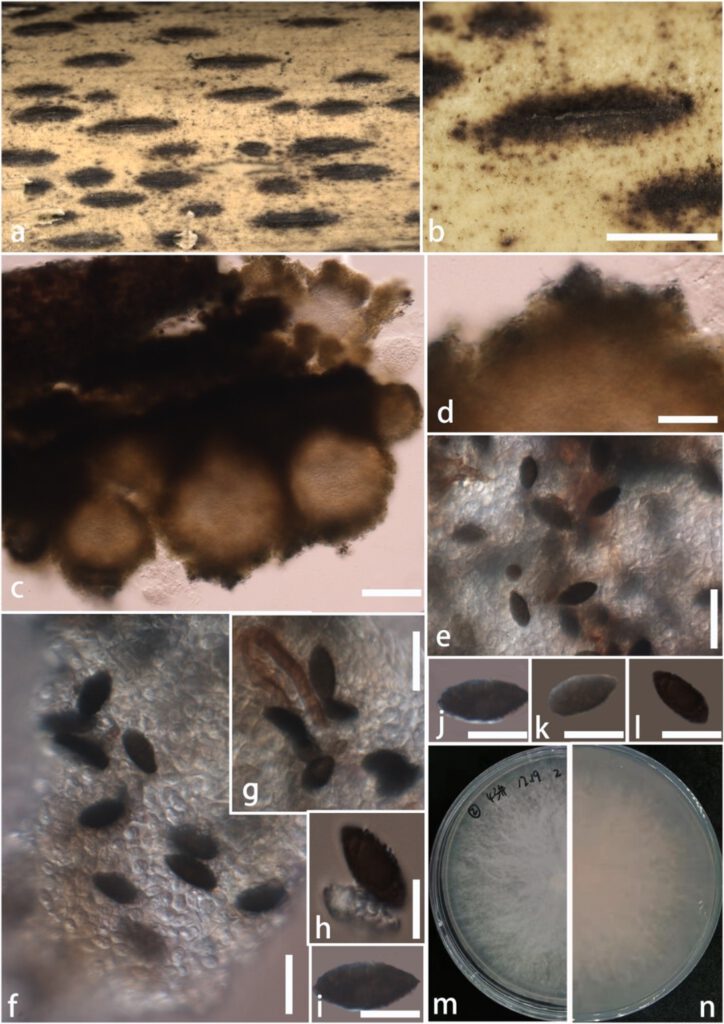Diatrypella guangdongense Zhao H.J., Manawas., K.D. Hyde, sp. nov.
Index Fungorum number:IF 559347; MycoBank number: MB 559347; Facesoffungi number: FoF 10627;
Etymology – Epithet refers to the Guangdong province, China from where the fungus was collected.
Holotype – ZHKU 21-0007
Saprobic on dead stems of Bamboo plant. Sexual morph: Undetermined. Asexual morph: Colomycetous. Conidiomata 40–125 µm high × 40–125 µm diam., semi-immersed, solitary, globose. Conidiomatal wall 20–35 µm composed of dark brown, thick-walled cells, becoming thin walled and hyaline toward the inner region. Conidia 15–20 × 5–10µm (= 15 × 7 µm, n = 11), dark brown walled, rough, ovoid.
Culture characteristics – Conidia germinated on PDA within 12 hours at 25°C. Colonies on PDA, reaching 60–70 mm diam. after 4 weeks at 25°C, Circular, surface rough, entire edge with dense mycelium, above and reverse white, aerial hyphae at the center. No pigments production.
Material examined – Danxia Mountain, Renhua County, Shaoguan City, Guangdong Province, China, from dead stems of Bamboo plant, E 113°44′22″, N 25°2′39″ 17 Novermber 2020, H.J. Zhao. (ZHKU 21-0007, holotype); living cultures, ZHKUCC 21-0114 ex–holotype; ZHKUCC 21-0115 ex–paratype.
Genbank numbers – ITS: OL770250;
Notes – The strain ZHKUCC 21-0114, isolated and described in this study. In the phylogenetic analysis, our new strains were clustered near with the Diatrypella verruciformis ((E hrh.) Nitschke, 1867) and Diatrypella banksiae (Crous, 2016) with 100%ML and 100% MP bootstrap values (Fig. 53). The two strains (ZHKUCC 21-0114 and UCROK 1467) have 48 base pair differences in the ITS regions and 59 base pair differences in the tub2 regions. The two strains (ZHKUCC 21-0114 and CPC 29118) have 45 base pair differences in the ITS regions and all base pair differences in the TUB2 regions, as CPC 29118 do not have TUB2 sequence data. Stromata verrucose or cushion-shape, 3-5 mm diam., black, with wrinkled surface and non-sulcate ostioles. Asci 100-120 × 10-14 μm. Ascospores 6-8 μm long. However, what we separated strain is asexual. For Diatrypella banksiae, conidia solitary, hyaline, smooth, spindle-shaped, apex subobtuse, base truncate, (25–)27–30(–35) × 1.5(–2) µm, while Diatrypella guangdongense conidia 15–20 × 5–10µm. Based on this obviously difference in morphological and molecular data, we introduced that isolate (ZHKUCC 21-0114) as a new species for Diatrypella guangdongense.

Figure 54 – Diatrypella guangdongense (ZHKUCC 21-0114: Holotype), a, b Appearance of conidiomata on host surface. c Conidioma. d Conidiomatal wall. e–l Conidia. m–n Culture characteristics on PDA. Scale bars: a = 1000 μm, b = 500 μm, e–l = 20 μm.
